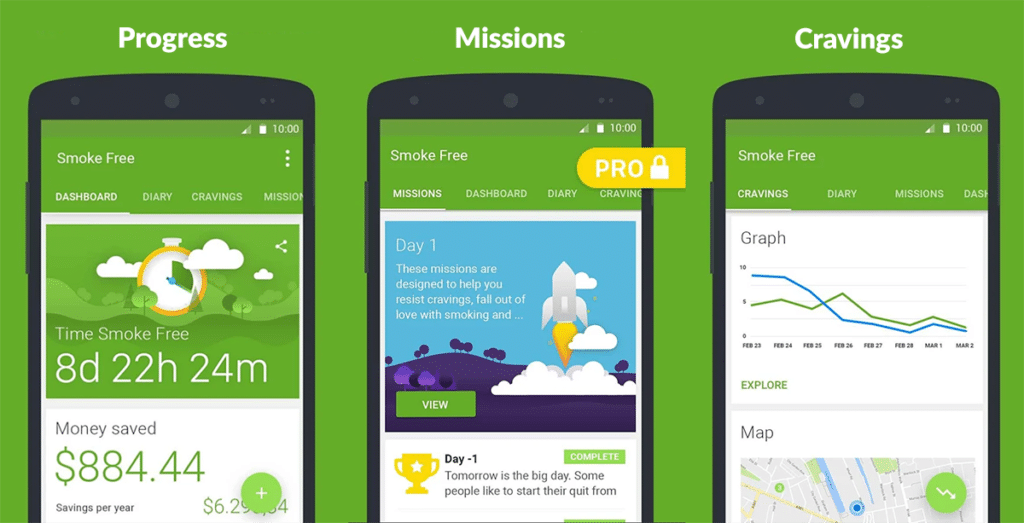Kerry smoked a pack of cigarettes a day for 11 years. Although she had tried to quit smoking many times, she’d never managed to do so successfully — until she discovered the Smoke Free app. Once she began using it, she reports, “I am now five weeks smoking-free, and I feel great. This app helped me throughout. Brilliant!”
With 3.5 million downloads and over 70,000 5-star reviews, Smoke Free’s popularity extends far beyond Kerry. As Dr. David Crane, the founder of the app tells us, today the app is downloaded a whopping 4,000 times a day. Clearly, Dr. Crane is a man who knows a little something about behaviour modification.
The Origins of the Smoke Free App
Dr. Crane didn’t begin his career with the intent of building one of the world’s most popular smoking cessation apps. He actually wanted to become a sports psychologist. However, when he expressed an interest in earning a Master’s in that field, he was told that first, he needed to study basic psychology.
So, he changed his focus and decided to pursue a Psychology General Master’s degree. When it came time to undertake his final project, he decided as a recent former-smoker to create a small smoking cessation app, geared toward addressing cigarette cravings.
As he got further along in the project, its scope changed and ultimately, he decided to create an app that actually set missions for its users. He says, “These small daily tasks were designed to help people fall out of love with smoking, recast themselves as non-smokers, feel proud about the benefits they had gained, and find new ways of dealing with cravings.”
The app was ultimately launched in February, 2013, and it gained a number of enthusiastic users almost immediately. Yet, Dr. Crane wasn’t satisfied. As he puts it, “The fundamental thing I realised was that in order to really help people change their behaviour and stop smoking with an app, I needed a lot more scientific background…
“I needed to know how to run experiments, because with these 4,000 users a day, it’s a really fantastic opportunity to test new approaches to smoking cessation, lapse prevention, and recovery from relapse.”
So, Crane returned to school to earn his PhD under Professor Robert West, a world leader in smoking cessation.
The Superior Design of the Smoke Free App
With additional schooling behind him, Dr. Crane worked with a scientific committee comprised of six world-leading behavioural scientists to further shape the app and make sure it was scientifically robust. Today, the app has three core elements.

Pictured: Screenshots taken from the Smoke Free app
i) Progress
The first is a progress element. Crane explains that it shows users, “How much money has been saved, how many cigarettes haven’t been smoked, how much time has been smoke-free, health improvements that have been made and other sort of indicators that help people see the gains that they have made from giving up smoking.
ii) Missions
“The second [element] is the missions. These are daily tasks which are partly designed to be motivational and partly designed to address the fundamental things which are known to cause people to return to smoking so, for example, a smoker’s identity. People come to see themselves as a smoker, so changing their identity around smoking so they see themselves as a non-smoker can be very helpful in helping them embrace their new life.
iii) Cravings
The third element addresses cravings. “One of the big things that causes a craving or causes a relapse is a sudden change in mood. So, you’re going along your day… and then you get a horrible email that sets you on a downward spiral, or a really brilliant one for that matter that perks you up and makes you feel you’ve earned a reward,” Crane says.
It’s obvious that a lot of thought has been put into the Smoke Free app. That’s by design. Crane explains, “What we’re trying to do is become more tailored to individual needs. Not a one-size fits all. One-size fits all doesn’t really work.”
Smoke Free App & the Medical Community
The response to the Smoke Free app from the medical community has been a positive one. While Crane mentions there hasn’t been any formal feedback, he says, “We’ve had doctors email us and say that they love it, [this app] is the one they recommend to their patients.”
The ease of use and high success rates probably have something to do with that. According to Dr. Crane, “People’s chances of staying smoke-free for 3 months were almost double if they used the app with the missions compared to if they used the app without the missions.”
Another reason the app is so useful is because doctors can’t be available to their patients 24/7 like an app can. Crane cites Rothman’s Theory of Behaviour Maintenance, explaining, “Rothman says that we initiate a new behaviour when we’re optimistic about the outcomes. So, we make the quit smoking attempt when we think, ‘Oh, you know what, I’m really going to feel so good about not smoking’ or ‘I’m fed up with smoking, I’m going to gain all these things from giving it up’. But he also says that we maintain a new behaviour only when we are satisfied with the outcomes of the new behaviour.
“So, if we change any behaviour and think, ‘Oh well, I haven’t gained very much from it’, then we’re likely to revert to the old behaviour… fundamentally what [Smoke Free] does is help people in between visits to the doctor see that, ‘I’m now 6 days and 5 hours 23 minutes smoke-free’. We show it to the penny how much people have saved. So when they can see that gain it helps them stay strong and resist these cravings.”
How Physicians can Introduce the Smoke Free App to Patients
Dr. Crane recommends a two-pronged approach. Physicians shouldn’t just mention quitting smoking, they should also be prepared to offer up a concrete suggestion on how to do so.
He says, “There’s a lot of evidence that brief advice for smoking cessation can be very motivational for patients… simply mentioning, ‘Oh, I see you’re a smoker, have you thought about quitting?’ can make patients go, ‘… this medical professional thinks that I should do something about this’.
“But then, the question from the patient is: ‘Well, how?’” Crane adds that although there are plenty of free resources available, people tend not to use them. In the UK, we’ve got stop smoking services where you can receive one-on-one or group therapy with a stop smoking expert. But people don’t really want to go to them, even though they are proven to be highly effective.
“I mean, the best thing you can do is use NRT (Nicotine Replacement Therapy) and this kind of behavioural support. But people don’t want to use in-person support, because it’s an effort to leave their house on a cold Tuesday evening”.
Fortunately, there’s an alternative. Smoke Free is a free app, that works on iPhones and Androids. You can learn more about Smoke Free here.
In Conclusion
Behaviour modification can be a tricky thing but fortunately, Dr. Crane has a good handle on it. With thousands of glowing app reviews, it’s safe to say that Smoke Free has truly made a difference in the lives of many former smokers.
As one user puts it, “I’ve ‘quit’ smoking many times… This time around, I feel like having this app has made a world of difference. I like having a place to log when cravings/withdrawals happen. The health improvement timeline is awesome and keeps me motivated to stick to it.
“Overall, it’s very useful and has helped me A LOT. My level of addiction is no joke, and I don’t think I would have made it this far without the app”.



